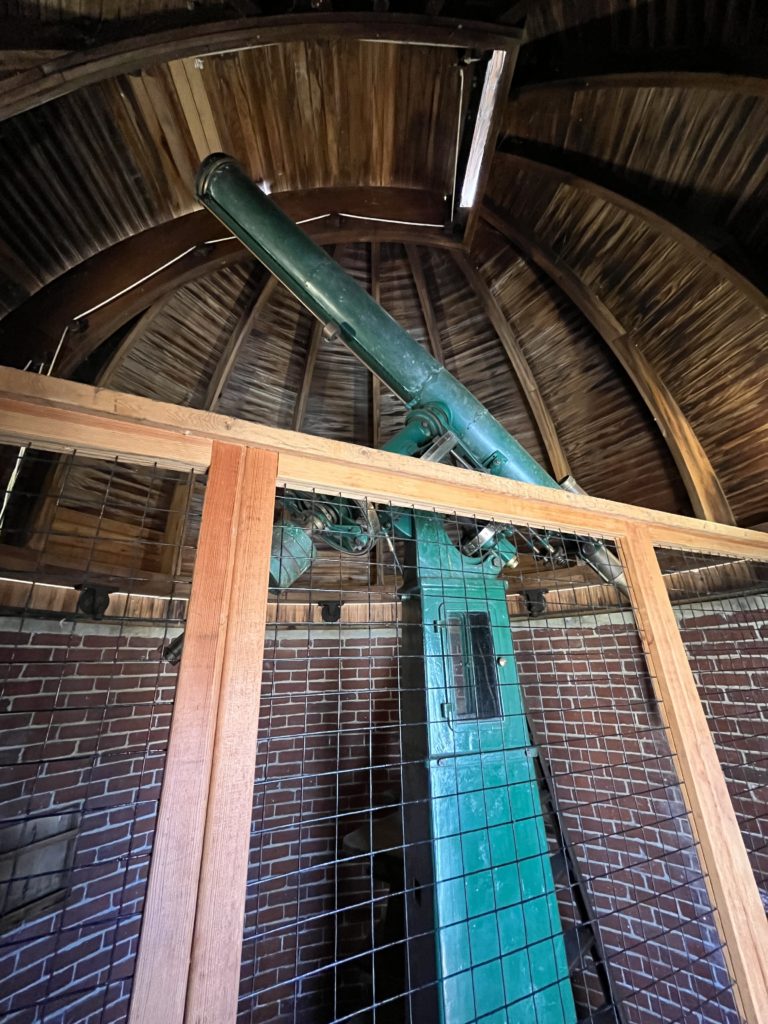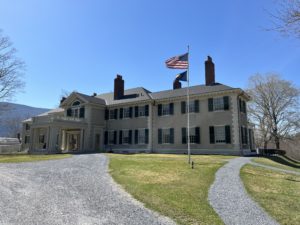 Mary Lincoln hated Washington, especially during the pestilent humidity of the capital city during the heat of summer. It’s the reason President Lincoln moved to the soldier’s home (now President Lincoln’s Cottage) each summer, beginning with 1862 after Willie’s death earlier that year. Mary would take Tad northward, often to New York and into New England, usually to be joined by Robert during his summer break from his studies at Harvard College. In 1863 they traveled to the White Mountains of New Hampshire, then in August of 1864 Robert met his mother and brother in the Green Mountains of Vermont. He intended to return with the president in the summer of 1865, but the assassination kept that from happening. Notwithstanding, the 1864 trip would capture Robert’s fancy enough to return decades later to build his own summer cottage known as Hildene.
Mary Lincoln hated Washington, especially during the pestilent humidity of the capital city during the heat of summer. It’s the reason President Lincoln moved to the soldier’s home (now President Lincoln’s Cottage) each summer, beginning with 1862 after Willie’s death earlier that year. Mary would take Tad northward, often to New York and into New England, usually to be joined by Robert during his summer break from his studies at Harvard College. In 1863 they traveled to the White Mountains of New Hampshire, then in August of 1864 Robert met his mother and brother in the Green Mountains of Vermont. He intended to return with the president in the summer of 1865, but the assassination kept that from happening. Notwithstanding, the 1864 trip would capture Robert’s fancy enough to return decades later to build his own summer cottage known as Hildene.
On their visit in 1864, the Lincoln family (minus the President, who was busy trying to save the Union), stayed at the Equinox House Hotel in Manchester. Manchester is in southwestern Vermont in Bennington County, home to the Robert Frost Stone House Museum, where the poet wrote some of the poems that garnered him four Pulitzer Prizes. It’s unknown whether Robert Lincoln ever met Robert Frost, although Frost frequented the area in the 1920s when Lincoln was in the final years of his life. In any case, Robert Lincoln had many opportunities to become familiar with the area long after his initial visit with his mother. In the 1890s, he commonly visited his Chicago law partner, Edward S. Isham, who had a large estate called Ormsby Hill just outside of town. Following Isham’s death, Lincoln returned for a two week stay at the Equinox Hotel and decided to buy land – conveniently adjacent to Ormsby Hill – to build “a modest summer place.” He named the resulting 24-room Georgian estate Hildene, combining the Old English words for hill (Hil) and valley (dene), reflecting the highland and lowland portions of the now 412-acre property.
Earlier this year I also traveled to Vermont, roughly following the route Robert would have followed as he made his way from Harvard. Even today the environment remains pristine. It’s no wonder Robert Frost was inspired to write his most famous poem, “Stopping by Woods on a Snowy Evening” while living at the Stone House. After a brief pilgrimage to Frost’s house, I moved on to my main goals in Manchester – the Equinox and Hildene.
I had booked a room at the Equinox Golf Resort and Spa because I wanted to feel the presence of Mary, Tad, and Robert as they enjoyed the time away from the constant trials of civil war. The Equinox was expanded in 1980 but retains the original portions where the Lincoln’s stayed. The sprawling, but intensely beautiful, white edifice now sprawls across several buildings while maintaining its historic charm. The Equinox Historic District is listed on the National Register of Historic Places. It’s impossible not to be awed by the history. My visit to Hildene wasn’t until the next morning so I had time to wander around Manchester to visit the compelling River Walk and Veterans Park, hit up the local independent bookstore (for Lincoln books, of course), and take in a late lunch at the quaint Mystic Restaurant.
When I finally did get to Hildene it was easy to see why Robert Lincoln felt at home there. Built when he was still president of the Pullman sleeping car company, Robert maintained his house in Chicago, then later when he was Secretary of War to two presidents, a house in Washington, D.C. But Hildene was where he went to relax. The home itself is cozy despite its two-dozen rooms (some of which were for his servants). While he did do some work there, he wanted it not as a show house for guests but as a retreat to escape the madness of corporate and government life. He even built himself an observatory where he could gaze at the stars. After Robert’s death in 1926, the house remained in the family, with his granddaughter, Mary Lincoln Beckwith (who everyone called Peggy), the last Lincoln descendant to live at Hildene. She died in 1975, leaving the property (at least briefly) to the Church of Christ, Scientist in accordance with her grandmother’s wishes. It wasn’t long before Hildene was transferred to the nonprofit Friends of Hildene that now owns and runs it.
There is much more about Hildene to talk about, including the Pullman car and goat farm, but I’ll save those for another day. Peggy herself deserves some discussion as she reminds me of another woman I admired, Katharine Hepburn.
[Photo: Hildene, 2023, by David J. Kent]

Lincoln: The Fire of Genius: How Abraham Lincoln’s Commitment to Science and Technology Helped Modernize America is available at booksellers nationwide.
Limited signed copies are available via this website. The book also listed on Goodreads, the database where I keep track of my reading. Click on the “Want to Read” button to put it on your reading list. Please leave a review on Goodreads and Amazon if you like the book.
You also follow my author page on Facebook.
David J. Kent is President of the Lincoln Group of DC and the author of Lincoln: The Fire of Genius: How Abraham Lincoln’s Commitment to Science and Technology Helped Modernize America and Lincoln: The Man Who Saved America.
His previous books include Tesla: The Wizard of Electricity and Edison: The Inventor of the Modern World and two specialty e-books: Nikola Tesla: Renewable Energy Ahead of Its Time and Abraham Lincoln and Nikola Tesla: Connected by Fate.



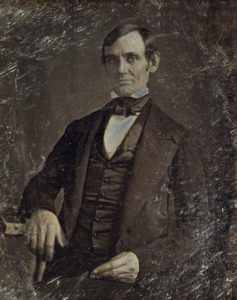 In 1855, the Whig Party had all but fallen apart. Always a Whig in politics, Lincoln was deciding whether to join the new Republican Party. The American Party, called the Know-Nothings because of their habit of denying any knowledge if asked about the party, had also been making inroads with a platform based on bigotry toward foreigners and Catholics (often Irish immigrants). In a letter written August 24, 1855, he tells his longtime friend Joshua Speed that “I am not a Know-Nothing. That is Certain. How could I be? How can anyone who abhors the oppression of negroes, be in favoring of degrading classes of white people?”
In 1855, the Whig Party had all but fallen apart. Always a Whig in politics, Lincoln was deciding whether to join the new Republican Party. The American Party, called the Know-Nothings because of their habit of denying any knowledge if asked about the party, had also been making inroads with a platform based on bigotry toward foreigners and Catholics (often Irish immigrants). In a letter written August 24, 1855, he tells his longtime friend Joshua Speed that “I am not a Know-Nothing. That is Certain. How could I be? How can anyone who abhors the oppression of negroes, be in favoring of degrading classes of white people?”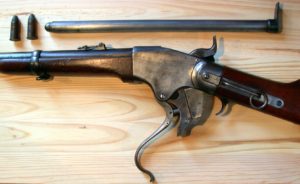 On August 17, 1863, Christopher M. Spencer, inventor of Spencer rifle, presents his new repeating rifle to President Abraham Lincoln and demonstrates how to assemble it. Lincoln was always keen on implementing new military technology during the Civil War, although his generals were not always so eager to follow his lead. Chief of Ordnance James Wolfe Ripley argued that more advanced weaponry was not self-evidently better in the field. Complicated weapons in the hands of untested soldiers and poor weather conditions led to vast inefficiencies in his mind, so Ripley denied the use of some of the new-fangled ideas Lincoln liked.
On August 17, 1863, Christopher M. Spencer, inventor of Spencer rifle, presents his new repeating rifle to President Abraham Lincoln and demonstrates how to assemble it. Lincoln was always keen on implementing new military technology during the Civil War, although his generals were not always so eager to follow his lead. Chief of Ordnance James Wolfe Ripley argued that more advanced weaponry was not self-evidently better in the field. Complicated weapons in the hands of untested soldiers and poor weather conditions led to vast inefficiencies in his mind, so Ripley denied the use of some of the new-fangled ideas Lincoln liked.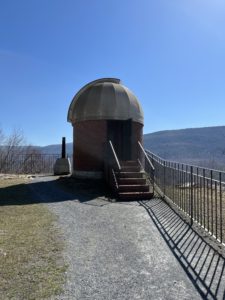 Robert Lincoln got his initial interest in astronomy from his father. Abraham Lincoln was fascinated by astronomy, as I discuss in my book,
Robert Lincoln got his initial interest in astronomy from his father. Abraham Lincoln was fascinated by astronomy, as I discuss in my book, 